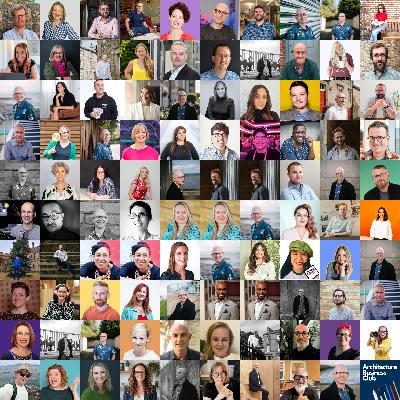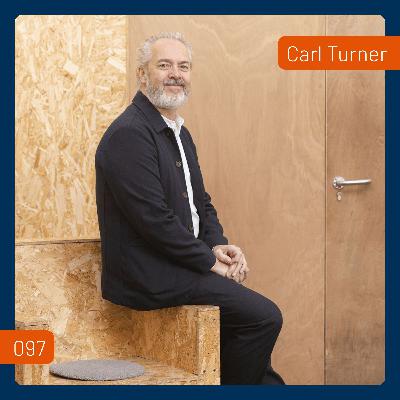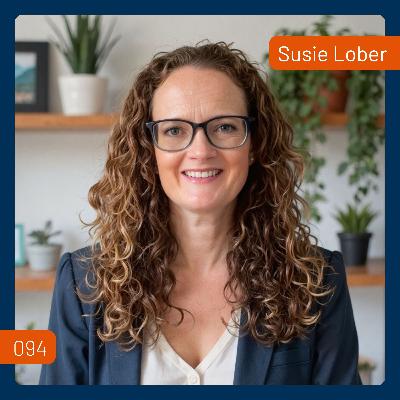Discover Architecture Business Club with Jon Clayton
Architecture Business Club with Jon Clayton

Architecture Business Club with Jon Clayton
Author: Jon Clayton
Subscribed: 29Played: 538Subscribe
Share
© Copyright 2025 Jon Clayton
Description
Architecture Business Club is the weekly podcast to help solo and small firm architecture business owners build a profitable, future-proof architecture practice that both you and your clients love! It’s an inclusive place (for ALL architecture business owners). So whether you’re an Architect, Architectural Technologist, or Architectural Designer…If you sell architectural services and want to improve the way you do things…This is THE podcast for you.
I’m Jon Clayton, your show host, and a Chartered Architectural Technologist based in the UK. I’ve been in architecture for over two decades and running my own (solo) practice for 10 years+.
Each week you’ll hear from inspiring people from the world of architecture and business who share actionable tips to help you improve how you work, save time, or make more money. I’ll also share my own experiences running an architecture business in occasional solo episodes. We cover everything from mindset, money, business strategy, sales & marketing, productivity, systems & workflows, client experience, outsourcing, software, technology, and much more.
Episodes are kept as short as possible by cutting out the fluff and getting straight to the point. So expect interview episodes of around 30 minutes or less, and solo episodes of 5 to 15 minutes.
New episodes are released every Thursday at 6am GMT / 2am EST.
Welcome to the Club!
I’m Jon Clayton, your show host, and a Chartered Architectural Technologist based in the UK. I’ve been in architecture for over two decades and running my own (solo) practice for 10 years+.
Each week you’ll hear from inspiring people from the world of architecture and business who share actionable tips to help you improve how you work, save time, or make more money. I’ll also share my own experiences running an architecture business in occasional solo episodes. We cover everything from mindset, money, business strategy, sales & marketing, productivity, systems & workflows, client experience, outsourcing, software, technology, and much more.
Episodes are kept as short as possible by cutting out the fluff and getting straight to the point. So expect interview episodes of around 30 minutes or less, and solo episodes of 5 to 15 minutes.
New episodes are released every Thursday at 6am GMT / 2am EST.
Welcome to the Club!
113 Episodes
Reverse
Jon discusses the importance of personal branding with expert Christine Gritmon. Christine breaks down what personal branding is, why it matters, especially for solopreneurs and small business owners, and shares her five-part Inside Out personal branding methodology: Purpose, Passion, Person, Personality, and Personal Brand. The conversation delves into the significance of authenticity, how to make a memorable impression, and offers practical exercises for identifying and leveraging your unique gifts. The episode concludes with actionable tips for starting to develop an authentic personal brand today.Today’s GuestWe’re joined by Christine Gritmon - Christine reconnects solopreneurs, freelancers, and small business owners with their purpose and passions for a more aligned personal brand that’s joyful, authentic, and impossible to ignore! She’s spoken on stages worldwide and is a frequent expert guest on podcasts, live streams, chats, and blog posts, as well as hosting her own podcast, Let’s Talk About Brand.—Episode Highlights00:00 Introduction00:42 Meet Christine Gritmon01:15 What really is Personal Branding?02:03 Personal Branding Misconceptions04:11 Why Personal Branding Matters So Much05:40 Building Trust Through Branding06:13 The Power of Authenticity11:44 The Inside Out Branding Framework12:05 Purpose and Passion15:25 Identifying Your Gifts20:42 How You Show Up In The World21:57 The Role of Personality23:50 Expanding Your Personal Brand24:38 Jon's Gift28:24 Leading with Your Gifts29:35 Christine's Personal Branding Evolution30:30 The Flexibility of Personal Branding31:15 Embracing Your Unique Gifts32:22 Final Takeaways on Personal Branding32:52 Connecting with Christine Gritmon—Key TakeawaysBe authentic and true to yourselfYour personal brand should come from who you really are, not from trying to fit into someone else’s idea of success. When you show your true self, people are more likely to trust you and remember you.Lead with your unique giftsEveryone has something special to offer. Focus on the skills and qualities that make you different, and use them in your work. This not only helps you stand out, but also makes your brand flexible if you change direction in the future.Your personal brand goes further than you doA strong personal brand can open doors and create opportunities, even when you are not in the room. The impression you leave with others can travel far, helping your reputation and bringing new connections your way.—Click here to connect with Christine on LinkedIn 🤝Click here to learn more about Christine Gritmon 🖥️Ready to start podcasting? Click here to book a chat with Jon 🎧Follow or Connect with Jon on LinkedIn 🤝—👇 And if you enjoyed this episode…Please leave a 5-star review or rating wherever you listen to podcasts, and don’t forget to hit the subscribe button so you never miss an episode.—Next EpisodeNext time Jon chats with Louise Brogan about getting more from your LinkedIn company page.
In this episode of the Architecture Business Club podcast, host Jon Clayton reflects on the podcast's impact and announces several upcoming changes aimed at broadening its audience and improving content delivery. Key changes include the transition to both audio and video formats, a shift to fortnightly episode releases, and a tighter editing process to focus on core topics. Jon also discusses the possibility of releasing video versions of past episodes and explores securing a long-term sponsor that aligns with the show's mission. Listeners are encouraged to provide feedback on these updates and suggest potential sponsorship partners.—Episode Highlights00:00 Introduction01:01 New Audio and Video Formats02:01 Content and Format Adjustments05:25 Editing and Production Process07:05 Release Schedule Update08:48 Focus on Interview-Based Episodes10:57 Exploring New Podcast Ideas11:27 Sponsorship and Ads15:22 Summary and Conclusion—Key TakeawaysThe importance of adaptability: The episode demonstrates how being flexible and open to change can help you overcome unexpected challenges and seize new opportunities.Effective communication is key: Clear, honest, and timely communication between all parties involved helps to prevent misunderstandings and ensures that everyone is aligned towards common goals.Continuous learning drives progress: Embracing a mindset of ongoing learning and self-improvement allows for personal and professional growth, keeping individuals and organisations competitive in a rapidly evolving environment.—Subscribe on YouTube (for upcoming video episodes!) 📺Send a Voicemail to the show (we listen to every message!) 📢Curious about podcasting? Click here to book a chat with Jon 🎧Want to meet people like you? Click here to join our community waitlist 🤝Follow or Connect with Jon on LinkedIn 🤝—👇 And if you enjoyed this episode…Please leave a 5-star review or rating wherever you listen to podcasts, and don’t forget to hit the subscribe button so you never miss an episode.—Next EpisodeNext time Jon chats with Christine Gritmon about personal branding.
Jon is joined by Natalie Doremieux, a membership and tech strategist with over 10 years of experience. They delve into the numerous benefits of podcast guesting for business growth. Natalie shares her expertise on why podcast guest appearances are valuable, the importance of having a podcast guesting strategy, and how to find the right podcasts to guest on. Listeners will also learn effective strategies to repurpose guest appearances for maximum value. Additionally, they discuss building trust, connecting with the audience, and crafting a compelling narrative to achieve business objectives. Tune in to discover how you can leverage podcast guesting to enhance visibility, build trust, and align with your business goals.Today’s GuestNathalie Dorémieux is a membership and tech strategist with over 10 years experience helping coaches and course creators design high-retention programs that drive real results. In 2025, she co-created Podcast LeadFlow, a tool that turns podcast episodes into high-quality lead magnets using smart automations and AI. Nathalie’s work blends strategy, tech, and a human-first approach - with a dash of French flair.—Episode Highlights00:00 Introduction to Podcast Guesting00:30 Welcome to Architecture Business Club00:49 Meet Natalie Doremieux01:40 Why Be a Podcast Guest?03:02 Building Trust Through Podcasting04:05 The Importance of a Podcast Guesting Strategy07:15 Defining Your Podcast Guest Strategy08:30 Connecting with Your Audience10:32 Finding the Right Podcasts To Guest On15:29 The Power of Networking16:03 Researching Podcast Guest Opportunities16:35 Making a Good Impression as a Podcast Guest19:56 Crafting Your Message as a Podcast Guest23:31 Sharing Your Unique Approach as a Podcast Guest28:40 Leveraging Podcast Appearances31:38 Repurposing Podcast Content35:13 The Value of Podcasting36:59 Getting Started with Podcasting38:49 Commitment and Podcast Seasons40:28 Final Thoughts and Connection—Key TakeawaysHaving a clear podcast guesting strategy is essential for aligning your appearances with your business goals and reaching your ideal audience.Building trust and authentic connections through podcast guesting is far more effective than simply promoting your expertise; sharing your story and values helps you stand out.The value of podcast guesting extends beyond the interview itself—repurposing your appearances and treating them as lead-generating assets can significantly boost your business growth.—Click here to take your next step after listening 🖥️Click here to connect with Nathalie 🤝Ready to start podcasting? Click here to book a chat with Jon 🎧Follow or Connect with Jon on LinkedIn 🤝—👇 And if you enjoyed this episode…Please leave a 5-star review or rating wherever you listen to podcasts, and don’t forget to hit the subscribe button so you never miss an episode.
Jon interviews Nicla Diceglie, founder of Nicla D Interiors. Nicla shares her transformative journey from a stressful career as a project manager in London to embracing bold biophilic design inspired by her own battle with depression. She discusses the importance of nature and colour in creating spaces that nurture and restore well-being. The conversation touches on the therapeutic benefits of nature, the challenges of starting a new business during COVID-19, and the unique aspects of bold biophilic design. Nicla also shares her love of travel, architecture, and some of her favourite places around the world. Tune in to learn how embracing biophilic design can enhance your health, happiness, and personal growth.Today’s GuestNicla Diceglie is the founder of Nicla D. Interiors. After experiencing the healing power of nature and colour in her own life, Nicla founded Nicla D. Interiors to help others create bold biophilic spaces that support happiness, health, and personal growth. Nicla helps people turn their homes into joyful, nature-inspired sanctuaries - spaces that heal, energise, and make them happier and healthier.—Episode Highlights00:00 Introduction00:56 Meet Nicla Diceglie: Founder of Nicla D Interiors03:34 Nicola's Journey: From Italy to London05:06 The Turning Point: Leaving the Job08:06 Embracing Nature: The Healing Power of the Outdoors09:37 Starting Fresh: A New Career in Interior Design14:49 Launching Nicla D Interiors19:34 Challenges of Starting a Business During COVID21:46 Finding Your Passion and Alignment22:49 Introduction to Biophilic Design27:03 The Journey to Biophilic Design31:43 Benefits of Biophilic Design37:09 A Day in the Life of a Biophilic Designer39:07 Final Thoughts and Takeaways40:23 Favourite Travel Destinations42:08 Connect with Nicla42:51 Closing Remarks—Key TakeawaysSpending time in nature can improve your mood and well-being. Even simple activities like walking in the park or adding plants to your home can make a positive difference.The spaces where you live and work should help you feel comfortable and happy. Bright colours, natural light, and personal touches can turn any space into a place that supports your health.It is possible to change your career or life direction if you are not satisfied. Following your interests and passions can lead to a more fulfilling and enjoyable life.—Click here to connect with Nicla on Instagram 🤝Click here to learn more about Nicla D Interiors 🖥️Curious about podcasting? Click here to book a chat with Jon 🎧Want to meet people like you? Click here to join our community 🤝Follow or Connect with Jon on LinkedIn 🤝—👇 And if you enjoyed this episode…Please leave a 5-star review or rating wherever you listen to podcasts, and don’t forget to hit the subscribe button so you never miss an episode.—Next EpisodeNext time Jon is joined by Nathalie Doremieux to learn how to get the most value from your podcast guest appearances.
Jon welcomes Daniel Patterson, an experienced business growth strategist, to discuss smart strategies for doubling profit without hiring more staff or increasing marketing expenses. They explore the pitfalls of trying to please everyone, the importance of discussing money early on, and effective pricing strategies. Daniel shares his insights on reducing overhead by optimising team roles and asks the critical question of knowing who your dream client is. Tune in to uncover practical tips and transformative strategies to enhance profitability in your architecture practice.Today’s GuestDaniel Patterson is a former RIBA Part 1 with nearly two decades of experience helping businesses grow and scale. He is the founder of Masterplan.pro and branding agency Highly, and has worked with the RIBA and RSAW to deliver CPD training on business and marketing strategy. Daniel is also the creator of The Architect’s Masterplan™, a 12-month growth system for architects who want to escape the tender trap and run highly profitable, sought-after practices.—Episode Highlights00:00 Introduction00:37 Meet Daniel Patterson01:57 Daniel's Personal Interests03:20 The Profitability Challenge in Architecture09:20 Understanding the Value of Money in Architecture23:33 Strategies to Double Your Profit32:10 Maximising Profit Through Fractional Support34:33 The Power of Asking for Referrals37:13 Effective Pricing Strategies for Architects43:10 Identifying and Fixing Profit Leaks44:42 Real-Life Success Stories48:04 Practical Tips for Immediate Profit Improvement51:40 Overcoming the Fear of Failure57:16 Exploring the World: Travel Stories59:08 Final Thoughts and How to Connect—Key TakeawaysKnow Your Best Clients and Say No SometimesYou do not have to please everyone. When you try to make everyone happy, your best clients may not feel special. It is better to know who you really want to work with and focus on them. If someone is not a good fit, it is okay to say no.Talk About Money EarlyDo not be afraid to talk about money with your clients. If you talk about price at the start, you save time for both you and your client. This helps you find out quickly if you are a good match. It also stops you from working for less than you should.Ask for Referrals and Show Your ValueIf you do a good job, ask your clients if they know anyone else who might need your help. This is a simple way to find new work. Also, show your clients the value you bring, not just your price. When people see your value, they are happy to pay more.—Click here to connect with Daniel Patterson 🤝Click here to learn how much profit you are missing out on each year 🖥️Curious about podcasting? Click here to book a chat with Jon 🎧Follow or Connect with Jon on LinkedIn 🤝—👇 And if you enjoyed this episode…Please leave a 5-star review or rating wherever you listen to podcasts, and don’t forget to hit the subscribe button so you never miss an episode.—Next EpisodeNext time, Jon is joined by Nicla Diceglie, who shares her career journey to Bold Biophilic Design.
Jon addresses what to do when facing a shortage of clients or work. He shares his personal story of recent hardships* and explains the common mistakes to avoid when trying to attract new clients. He provides practical advice for fast sales, focusing on hot leads, and high-touch outreach. Jon also emphasises the importance of asking for help and using available resources to manage cash flow issues. The episode concludes with recommendations for related podcast episodes that delve deeper into lead generation and sales strategies.* Trigger warning: between 01:43 to 02:22 Jon briefly mentions death and bereavement.—Episode Highlights00:00 Introduction01:28 Personal Struggles and Business Impact03:14 Common Mistakes When Seeking Clients05:04 Effective Strategies for Fast Sales05:38 Practical Tips for Faster Sales08:45 Recap and Additional Resources10:25 Closing Remarks and Call to Action—Key TakeawaysFocus on hot leads - When you need more clients, you should talk to people who already know you, like your past or current clients. They are more likely to work with you again.Try not to panic - If you feel worried because work is slow, try not to panic. Take a moment to calm down, then make a plan to help your business.Talk to someone - You do not have to do everything alone. If you need help, ask someone you trust or talk to a professional for advice.—Curious about podcasting? Click here to book a chat with Jon 🎧Want to meet people like you? Click here to join our community 🤝Follow or Connect with Jon on LinkedIn 🤝—👇 And if you enjoyed this episode…Please leave a 5-star review or rating wherever you listen to podcasts, and don’t forget to hit the subscribe button so you never miss an episode.—Next EpisodeNext time Jon is joined by Daniel Patterson to explore how to double your profits (without hiring or spending more on marketing!).
Jon welcomes David Drazil, an architect, author, and creator of 'Sketch like an Architect.' They discuss how technology has overshadowed and nearly replaced the craft of architectural sketching in schools, leading to a decline in this essential skill among young professionals. David shares insights from his journey and mission to revive this art form, drawing on his experiences in Denmark and his global platform, which has helped thousands master architectural sketching. He highlights the cognitive benefits of sketching, from aiding in problem-solving and brainstorming to enhancing client interactions. They also discuss the advantages of using both traditional and digital sketching methods, and share success stories from students and professionals who have benefited from David's teachings. The episode underscores sketching as a universal, learnable language that enriches both the creative process and business communication in architecture.—Today’s GuestDavid Drazil is an architect, author, and creator of Sketch Like An Architect, a global platform helping architects and designers build confident drawing skills through a clear step-by-step method. Originally from the Czech Republic, David studied architecture in Denmark, where he noticed a big gap: sketching was expected, but rarely taught. That insight sparked a mission that’s grown into a worldwide movement — with over 300,000 followers, 15,000 students in his online courses, and three popular books. Today, David empowers creatives to communicate their ideas visually with clarity and confidence.—Episode Highlights00:00 Introduction00:45 Meet David Drazil: Architect and Sketching Advocate01:45 David's Personal Interests and Background03:56 The Importance of Sketching in Modern Architecture06:59 Personal Benefits and Practical Applications of Sketching13:26 Sketching as a Differentiator in Client Interactions23:11 Success Stories and Testimonials27:37 Final Thoughts on Sketching and Technology30:54 David's Favourite Places and Conclusion—Key TakeawaysSketching is a Timeless Skill That Sets You ApartYou learn that, even in an age dominated by digital tools and AI, the ability to sketch by hand remains a powerful differentiator. Sketching helps you communicate ideas quickly, build trust with clients, and stand out in interviews or meetings. It’s not about being perfect—it’s about being able to think and express visually in the moment.Anyone Can Learn to Sketch - It’s Not About TalentYou discover that sketching isn’t a gift reserved for the naturally talented. It’s a learnable skill that you can develop with practice. By embracing sketching, you open up new ways to brainstorm, solve problems, and engage with others, regardless of your starting point.Sketching Fosters Human Connection and CollaborationYou realise that sketching is more than just a technical skill; it’s a tool for collaboration and dialogue. When you sketch in front of others, you invite them into the creative process, encourage feedback, and create a shared understanding. This approach not only speeds up decision-making but also makes your work more engaging and client-focused.—Click here to connect with David Drazil 🤝Click here to learn more about Sketch Like An Architect 🖥️Curious about podcasting? Click here to book a chat with Jon 🎧a...
Jon welcomes internationally renowned architect Kevin Kennon, the founder and CEO of Beyond Zero DDC, to discuss his journey and innovative approach to sustainable design. Kevin shares his experiences, including his involvement in the World Trade Center design competition, and the concept of distributed practice. He explains how this model can help studios access the best talent while remaining competitive and nimble. Kevin also touches on the advantages of working with remote teams, the importance of harnessing new technologies like AI, and the future direction of the architecture profession. The episode provides valuable insights for architects on balancing tradition with innovation in the architecture industry.Today’s GuestKevin Kennon is an internationally renowned architect with over 40 years’ experience in sustainable and innovative design. He’s the founder and CEO of Beyond Zero DDC, leading the creation of zero-carbon luxury eco-resorts around the world. His portfolio includes major projects such as the Barclays North American Headquarters, the Rodin Museum in Seoul, and award-winning Bloomingdale’s stores. A finalist in the World Trade Center design competition, Kevin has received over 40 international design awards and has work in MoMA’s permanent collection. He also lectures at top universities and contributes widely to discussions on urban development and climate change.—Episode Highlights00:00 Introduction00:45 Meet Kevin Kennon04:10 Understanding Distributed Practice10:19 Challenges and Misconceptions of Remote Teams16:49 Success Stories of Distributed Practice22:24 Kevin's Career Journey25:20 9/11, Ground Zero, and the World Trade Centre Design Competition27:56 Advantages of Running Your Own Practice30:46 The Future of Architecture and AI39:08 Advice for Younger Practices43:55 Main Takeaways45:32 Favourite Travel Destination46:42 Final Thoughts—Key TakeawaysYou can achieve more by building teams for each project and working with people from different places. This helps you find the right skills and makes your work stronger.You should be open to new ideas and ways of working. Using technology and working with others online can help you keep up with changes in your field.You will grow if you keep learning and share your knowledge with others. Every project is a chance to learn something new, and working together makes your work better.—Liked our guest? Click here to connect with them 🤝Click here to learn more about Kevin’s work 🖥️Curious about podcasting? Click here to book a chat with Jon 🎧Want to meet people like you? Click here to join our community 🤝Follow or Connect with Jon on LinkedIn 🤝—👇 And if you enjoyed this episode…Please leave a 5-star review or rating wherever you listen to podcasts, and don’t forget to hit the subscribe button so you never miss an episode.—Next EpisodeNext time, Jon chats with David Drazil to explore whether design professionals still need sketching skills.
Jon welcomes William Ringsdorf, founder of William Ringsdorf Consulting, who shares insights on how architecture firms can master profitability and process. William explains that most pricing issues stem from a failure to clearly communicate value and set proper boundaries. He discusses the systemic problem of undervaluing expertise in the field, highlights the importance of knowing one's numbers, and suggests implementing tiered service proposals to offer clear value to clients. William also offers practical steps for architects to increase their fees and improve profitability while reducing scope creep and burnout. He stresses the need for tracking data and continuous improvement in business practices.—Today’s GuestWilliam Ringsdorf is the founder of William Ringsdorf Consulting. He helps architecture firms master profitability, process, and purpose, turning chaos into clarity so you can design with freedom and confidence. Drawing on three decades of UK and German project experience, his coaching blends practical systems with architectural insight. This work is part of Into The Nest, an award-winning sustainable practice, giving his guidance credibility and a live design context.—Episode Highlights00:00 Introduction00:28 Meet William Ringsdorf03:08 The Issue of Undervaluing Expertise05:52 Understanding the Systemic Problem12:22 5 Steps to Fix Undervaluing Your Expertise19:59 Success Stories and Practical Examples23:33 Final Thoughts and Key Takeaways27:35 Closing Remarks and Contact Information—Key TakeawaysDo a Value Audit and Communicate Your Worth ClearlyStart by taking a close look at all the ways you help your clients. This means thinking about how you reduce risks, save time and money, and create certainty for them. Once you understand your value, make sure you talk about it openly with your clients. Don’t just focus on the hours you work or the tasks you do - explain the real benefits and outcomes you deliver. When clients see the value you bring, they are less likely to argue about price.Know Your Numbers and Set BoundariesIt’s important to know exactly what you need to charge to cover your costs, pay yourself fairly, and make a profit. Work out your effective hourly rate based on real projects, including all your overheads. Then, set clear boundaries in your proposals. Offer different service tiers (like basic, standard, and premium) so clients can choose what suits them, but always be clear about what is included in each option. This helps avoid “scope creep” where you end up doing extra work for free.Be Confident - Raise Your Fees and Practise Sales ConversationsDon’t be afraid to increase your fees. Try adding 10–15% (or even 20%) to your next proposal. Most clients will accept this if you have explained your value well. Practise having fee conversations and handling objections, even if it feels uncomfortable at first. The more you practise, the more confident you will become. Remember, you are worth it, and charging what you deserve helps you run a better, more sustainable business.—Liked our guest? Click here to learn more about them 🤝Click here to grab a free copy of William’s e-book 🖥️Curious about podcasting? Click here to book a chat with Jon 🎧
Jon celebrates the major milestone of 100 episodes by featuring reflections, tips, and good wishes from past guests and listeners. This special 100th edition features messages from diverse voices, including architects, entrepreneurs, and business experts, who discuss the impact of the podcast on their personal and professional lives. The episode highlights the show's commitment to providing valuable insights and practical advice for running a successful architecture business. Tune in for heartfelt congratulations and essential business tips from notable guests as Jon marks this significant achievement.—Episode Highlights00:00 Introduction00:58 Guest Congratulations02:15 Reflections from Past Guests11:32 Messages From Listeners13:03 Tips on Content, Consistency, and Marketing17:16 Advice on Positioning Your Services and Making Sure Clients Are Ready19:36 Tips on Implementation, Getting Visible, and Thought Leadership25:11 Guidance on Running The Business and Knowing Your Numbers29:04 The Human Side of Architecture and Business31:55 Ideas For Future Episodes34:55 Final Messages from a Guest and a Listener37:22 Wrap Up—ContributorsAnge Lyons, Anna Lundberg, Ann Vanner, Antoinette Chappell, Aya Shlachter, Beatrice Ronchetti, Bob Gentle, Bryon McCartney, Catherine Turner, Chris Ducker, Chris Simmons, Colin Gray, Derek Timms, Doug Hodgson, Ellie Senior, Fabio Zammit, Hayley Watts, Helen Nurse, Helen Tebay, Jackie Goddard, James Talman, Janine Coombes, Joe Wright, Laura Pearman, Lee Smith,
Jon shares practical advice on how to manage when life throws unexpected challenges your way. He discusses the importance of prioritising essential tasks, surrounding yourself with positive people, celebrating small wins, and the value of taking a break when needed. Throughout the episode, Jon draws on his recent personal experiences and offers tips on how to maintain balance and well-being during difficult times. Whether you're a seasoned business owner or just starting out, these insights will help you navigate tough seasons and continue to find success and fulfilment in your architecture business.Episode Highlights00:00 Introduction00:43 Personal Challenges and Coping Strategies01:27 Pause Non-Essentials02:57 Low-Energy Tasks04:18 Spending Time with Lifter Uppers05:51 Finding the Good Stuff06:40 Celebrate Small Wins07:46 Taking Time Off08:33 Be Kind to Yourself09:29 Conclusion and Next Episode TeaserKey TakeawaysPrioritise Essentials and Allow Yourself to PauseWhen facing tough times, focus on what is truly essential in your business and life. It is perfectly acceptable to pause or drop non-essential tasks, lightening your load until you feel ready to pick them up again.Seek Support and Celebrate Small WinsSpend time with supportive people - your “lifter uppers” - who can help boost your spirits. Also, remember to celebrate your achievements, no matter how small, as these moments of progress are important for maintaining motivation.Be Kind to Yourself and Take Breaks When NeededPractise self-compassion and look after your own wellbeing. If you need to take time off, do so without guilt. Tough seasons don’t last forever, and it’s important to take care of yourself to get through them.Curious about podcasting? Click here to book a chat with Jon 🎧Want to meet people like you? Click here to join our community 🤝Follow or Connect with Jon on LinkedIn 🤝👇 And if you enjoyed this episode…Please leave a 5-star review or rating wherever you listen to podcasts, and don’t forget to hit the subscribe button so you never miss an episode.Next EpisodeNext time, it’s our 100th episode - so I’ve put together something special, with a little help from some friends of the show.
From Award-Winning Homes to Transformative Community Projects - Jon continues his chat with Carl Turner about his journey from traditional residential projects to pioneering public and community-focused developments. Carl shares the pivotal moment of selling his award-winning home to fund Pop Brixton, a transformative community workspace made from shipping containers. This bold move opened new opportunities for Carl's practice, leading to more impactful projects like Peckham Levels and Hackney Bridge. Carl highlights the importance of taking risks, embracing failure, and self-initiating projects to create meaningful architectural work. The discussion also explores the evolving nature of Turner.Works, their future ambitions, and the significance of designing spaces that people can adapt and thrive in.—Today’s GuestCarl Turner is the founder of Turner Works, an architecture and urban design studio specialising in the early activation of sites and the meanwhile use of buildings. Carl has founded and set up several meanwhile projects, including Pop Brixton, Peckham Levels and Ashford Coachworks. The building of his own Brixton home was filmed by Grand Designs, and Carl has gone on to feature on Channel 4's 'Ugly House To Lovely House' as an expert in low-cost, high-impact design.—Episode Highlights00:00 Introduction01:12 The Pop Brixton Project07:58 Expanding Horizons: Peckham Levels and Hackney Bridge09:44 Transforming Turner.Works13:57 Future Aspirations and Stability23:20 Embracing Failure and DIY Ethos29:27 Travel Tales and Final Thoughts—Key TakeawaysTaking risks and learning from failure can lead to new opportunities and growth. If you try new things, even if you fail, you will learn and move forward.Working with others and building a strong team helps you achieve more than working alone. You do better when you share ideas and support each other.Creating spaces and projects that people can use and enjoy is more important than just making something look perfect. When you focus on real needs, your work has a bigger impact.—Click here to connect with Carl on LinkedIn 🤝Click here to learn more about Turner.Works 🖥️Curious about podcasting? Click here to book a chat with Jon 🎧Want to meet people like you? Click here to join our community 🤝Want more freedom? Grab the Architecture Business Blueprint 🎁Follow or Connect with Jon on LinkedIn 🤝—👇 And if you enjoyed this episode…Please leave a 5-star review or rating wherever you listen to podcasts, and don’t forget to hit the subscribe button so you never miss an episode.
Jon chats with award-winning architect Carl Turner, founder of Turner.Works. Carl shares the first part of his career journey. From his beginnings as a mature student to building an amazing reputation for residential projects. He won a string of prestigious awards along the way. Several of Carl’s projects have featured on TV shows like George Clarke's Ugly House To Lovely House & Grand Designs. In 2013, Carl’s own home, Slip House, won the RIBA Manser Medal, and in 2021, Hove House won Grand Designs House of The Year. Carl talks about the benefits of hands-on construction for building designers, the importance of teamwork, and his itch to make a larger impact through public architecture. Plus the ups and downs of running his own firm straight out of university and the valuable lessons learned along the way.Today’s GuestCarl Turner is the founder of Turner Works, an architecture and urban design studio specialising in the early activation of sites and the meanwhile use of buildings. Carl has founded and set up several meanwhile projects, including Pop Brixton, Peckham Levels and Ashford Coachworks. The building of his own Brixton home was filmed by Grand Designs, and Carl has gone on to feature on Channel 4's 'Ugly House To Lovely House' as an expert in low-cost, high-impact design.Episode Highlights00:00 Introduction01:07 Meet Carl Turner03:53 The Importance of Taking Breaks06:36 Carl's Early Career and Starting Turner.Works11:14 Hands-On Construction Experience26:01 Building a Reputation and Winning Awards29:47 The Desire for Public Projects31:25 Transition to Community Development31:50 Conclusion and Next Episode TeaserKey TakeawaysGet Involved and Learn by DoingYou learn a lot when you get your hands dirty. If you help build things yourself, you understand how buildings really work. This makes you a better designer because you know what is possible and what is hard to do.Take Breaks and Make PlansYou need to take breaks and step back sometimes. When you do this, you can see things more clearly and make better choices. If you just keep working without stopping, you might miss out on good ideas or make mistakes.Work Together and Help OthersYou do better when you work as a team. If you help other people and listen to their ideas, you can finish projects more easily. It is not just about you; it is about everyone working together to make something great.Click here to connect with Carl on LinkedIn 🤝Click here to learn more about Turner.Works 🖥️Curious about podcasting? Click here to book a chat with Jon 🎧Want to meet people like you? Click here to join our community 🤝Want more freedom? Grab the Architecture Business Blueprint 🎁Follow or Connect with Jon on LinkedIn 🤝👇 And if you enjoyed this episode…Please leave a 5-star review or rating wherever you listen to podcasts, and don’t forget to hit the subscribe button so you never miss an...
Only 17% of small teams write down what they do. Most just try to remember everything, which leads to stress and feeling overwhelmed. Layla Pomper, CEO of ProcessDriven and a systems expert, talks about how to build strong systems in your business. She shares her own journey from running a carpentry business with her husband to helping over 2,100 clients and 119,000+ YouTube followers. Layla explains the difference between good tools and good systems, and why writing down what you do is so important. She also discusses common mistakes teams make, like relying too much on software. This episode of Architecture Business Club will help you understand why better systems are key, not more tools.Today’s GuestLayla Pomper is the CEO of ProcessDriven® and the go-to expert on systemizing small team operations. Since 2018, Layla has been using software, process documentation, and storytelling to guide over 2,100+ clients and 119k YouTube subscribers to “enjoy the process” so they can delegate, grow, or simply relax. Creator of the Systemization Snapshot™— an operations audit and report that has benchmarked the operations of hundreds of teams—Layla’s mission is to turn “build your business systems” into a game that small teams can win in any industry.Episode Highlights00:00 Introduction00:50 Meet Layla Pomper: CEO of ProcessDriven02:25 Layla's Journey from Carpentry to Systems04:26 The Importance of Documenting Business Systems05:48 Why Systems Matter More Than Tools07:17 The Pitfalls of Relying on Software12:52 Learning from Other Industries14:30 Defining Good Systems vs. Good Tools21:32 The Benefits of Writing Down Processes27:07 Tool Switching: Does It Solve Real Issues?29:27 Practical Steps to Improve Your Systems30:54 Final Thoughts and Takeaways34:50 Layla's Favourite Place and Closing RemarksKey TakeawaysWrite Things DownYou should not try to remember everything in your head. When you write down what you do at work, it helps you and your team know what needs to be done. This makes your job less stressful and stops you from forgetting important steps.Don’t Let Software Decide How You WorkIt’s easy to think that new tools or apps will fix your problems. But you should first decide how you want to work, then pick tools that fit your way. If you let the software choose for you, you might end up working in a way that does not suit you.Learn from OthersYou can learn good ideas from people in your own job and from other jobs too. Ask others how they do things and share what works for you. Sometimes, a simple trick from another business can help you do your work better.Connect with Layla on LinkedIn 🤝Click here to get your Free Operations Audit and Identify Your Team's Biggest Bottleneck in Minutes - take your Systemization Snapshot today. 🖥️Curious about podcasting? Click here to book a chat with Jon 🎧Want to meet people like you? Click here to join our community 🤝Want more freedom? Grab the Architecture Business Blueprint 🎁
Declutter Your Mind with Bullet Journaling! Jon shares how bullet journalling can help you reduce mental clutter and focus on what’s important. John, who has been using the bullet journal method for over a year, explains how it works and debunks common myths about it needing to be artistic. He highlights the ease and flexibility of this analogue method, making it a better alternative to digital tools that can be distracting. Jon provides simple instructions on getting started and the benefits of incorporating bullet journalling into your daily routine.00:00 Introduction01:18 Exploring Bullet Journaling02:32 Debunking Bullet Journaling Myths05:27 Jon's Bullet Journaling Journey13:38 Getting Started with Bullet Journaling18:33 Bullet Journaling Tips and Tricks20:44 Conclusion and Final Thoughts—Key TakeawaysYou can use bullet journaling to clear your mind. Writing things down helps you stop worrying about forgetting ideas and lets you focus on what matters.You do not need to be artistic or make your journal look perfect. Bullet journaling is for everyone, and you can keep it as simple as you like.You can use your journal to plan, keep track of your tasks, and look back at what you have done. This helps you see your progress and remember your small wins.—Visit the BuJo (Bullet Journal) WebsiteLiked our guest? Click here to connect with them 🤝Click here to learn more about [our guest’s services] 🖥️Curious about podcasting? Click here to book a chat with Jon 🎧Want to meet people like you? Click here to join our community 🤝Want more freedom? Grab the Architecture Business Blueprint 🎁Follow or Connect with Jon on LinkedIn 🤝👇 And if you enjoyed this episode…Please leave a 5-star review or rating wherever you listen to podcasts, and don’t forget to hit the subscribe button so you never miss an episode.Next EpisodeNext time, Jon is joined by Layla Pomper to uncover why you need better systems, not more tools.
Jon chats with Susie Lober, a marketing expert with over 20 years of experience working with architects. Jon and Susie discuss the pressures and challenges of modern marketing for architecture practices. They highlight the importance of focusing on quality over quantity and avoiding common marketing time wasters like chasing trends, fixating on social media metrics, producing content without strategy, endlessly tweaking websites, and ineffective networking. Susie emphasises the need for a sound marketing strategy, following up on networking efforts, and building trust with potential clients. The conversation underscores the value of intentional and consistent marketing efforts.Today’s GuestSusie Lober helps architects harness the power of marketing to get more of the work they want. If you're feeling overwhelmed by all the different marketing tools and tactics, Susie will help you identify what's most relevant to your business with down to earth practical advice. She is a Fellow of the Chartered Institute of Marketing with over 20 years experience marketing for architects both in practice and independently. She is also an editor of the RIBA publication ‘Cambridge Architecture’.Episode Highlights00:00 Introduction00:44 Meet Susie Lober02:30 Biggest Marketing Time Wasters02:56 Chasing Trends in Marketing07:22 The Pitfalls of Social Media Metrics11:20 Creating Purposeful Content14:17 Website Tweaks and Their Impact29:10 Effective Relationship Marketing36:54 Consistency in Marketing Efforts46:16 Final Thoughts and Takeaways48:20 Travel and Personal Recommendations49:48 Conclusion and Contact InformationKey TakeawaysFocus on What Matters, Not Just TrendsYou don’t need to follow every new marketing trend. Instead, think about where your audience is and what they care about. If your customers aren’t on a certain social media platform, you don’t have to be there either.Quality Over Quantity in ContentIt’s better to share helpful and interesting content than to post all the time. You don’t have to post every day. Make sure what you share is useful and fits your business. This way, people will remember you for the right reasons.Build Real Relationships and Keep in TouchMeeting people is just the start. You need to follow up and keep in touch with them. This helps you stay in their minds, so when they need your help, they will think of you first. Little and often is better than doing a lot all at once and then stopping.Click here to connect with Susie on LinkedIn 🤝Click here to learn more about Susie’s marketing workshops 🖥️Curious about podcasting? Click here to book a chat with Jon 🎧Want to meet people like you? Click here to join our community 🤝Want more freedom? Grab the Architecture Business Blueprint 🎁Follow or Connect with Jon on LinkedIn 🤝👇 And if you enjoyed this episode…Please leave a 5-star review or rating wherever you...
Jon is joined by Antoinette Chappell, an expert in executive thought leadership and content creation. They discuss the importance of standing out with original insights and effective content implementation. Antoinette shares her journey from translation to copywriting, and the necessity of strategic, long-form content to build authority in your field. They explore the role of thought leadership in career growth, the impact of AI on content creation, and the significance of having a strong content strategy. Also, Antoinette talks about Property Connect networking events and the value of face-to-face networking in the property and construction industries.Today’s GuestAntoinette Chappell has worked in two professions heavily transformed by AI and automation, yet has remained resilient and agile throughout. As a translator, she spotted automation trends early and pivoted into copywriting in 2019, ahead of the industry curve. In 2023, she wrote "Copy that!" to help fellow translators develop additional revenue streams, guidance that professional bodies are only now advocating. Antoinette now specialises in executive thought leadership, transforming busy leaders' insights into compelling long-form content. This forward-thinking approach exemplifies how she helps C-suite executives and founders lead industry conversations rather than reflect on what has been.Episode Highlights00:00 Introduction00:39 Meet Antoinette Chappell03:08 Becoming a Thought Leader05:32 Benefits of Thought Leadership08:13 Long Form vs Short Form Content11:07 SEO and Quality Content16:49 Strategic Content Planning20:30 Engaging Content for Professional Services22:31 Personal Touch in Professional Posts23:07 Consistency and Strategy in Posting23:43 Building a Recognisable Brand24:45 The Long-Term Benefits of Quality Content28:07 Evolving with Industry Changes32:46 Networking and Property Connect35:19 Final Thoughts and Takeaways36:15 Favourite Travel Destinations39:21 Conclusion and Contact InformationKey TakeawaysYou need to share your own ideas and stories to stand out. If you want people to notice you, don’t just copy what others say. Use your own experience and show what makes you different.You should have a plan for your content. Think about who you want to help, what they want to know, and when you will share your posts. If you post with a plan, more people will see you as an expert.You don’t have to be the best or have worked for many years to be a leader. If you look ahead, learn new things, and share what you know, you can help others and become someone people trust.Like our guest? Click here to connect with them 🤝Click here to learn more about Antoinette's services 🖥️Find your nearest Property Connect Networking Event 🏡Curious about podcasting? Click here to book a chat with Jon 🎧Want to meet people like you? Click here to join our community 🤝Want more freedom? Grab the Architecture...
Jon welcomes Susanna Reay, the UK's authority architect and creator of the Spark process. They discuss the importance of building authority over visibility for sustainable business growth in architecture. Susanna shares her expertise on how architectural firms can effectively position themselves as the go-to experts in their field by focusing on their unique methods, offers, and distinctive content. The episode also highlights success stories of interior designers who transformed their businesses by uncovering their unique service premises. Through engaging examples and actionable insights, this episode provides a roadmap for architects and designers to build a credible and distinctive brand.Today's Guest...Susanna Reay is the UK's Authority Architect and creator of the SPARK Process™, dedicated to transforming brilliant but overwhelmed service providers into clear, confident authorities with scalable impact.Episode Highlights...00:00 Introduction00:46 Meet Susanna Reay: The Authority Architect04:26 Positioning Yourself as the Go-To Choice07:53 The Authority Spark Process11:15 Signature Methods and Unique Offers19:25 Real-Life Examples of Unique Service Premises30:47 Conclusion and Key Takeaways31:37 Final Thoughts and FarewellKey Takeaways...You don’t need to be everywhere to be successful.You might think you have to be on every social media platform and get lots of followers. But you don’t. It’s better to know what you want to be known for and build your skills and trust first. This helps you stand out without feeling tired or stressed.You have your own special way of doing things.Even if you learned the same things as others, you have your own method and style. When you find out what makes you different, you can use it to show people why they should choose you. Your unique way is your “calling card”.Share what you believe and what you care about.People want to know what you stand for. If you talk about your ideas and what matters to you, others will see you as a leader. This helps you become the go-to person in your field.Links Mentioned In The Episode...Connect with Susanna on LinkedInGet Susanna’s free resources to help position you as the go-to expert—--Want to launch a podcast?👉 Book a chat with Jon to explore working with him 📞Like to be a guest speaker on this podcast?👉 Click here to apply 📢Interested in joining our membership community?👉 Click here to JOIN THE WAITLIST 😀Resources…👉 Grab the Architecture Business Blueprint 🎁It’s the step-by-step formula to freedom for architects, architectural technologists, and architectural designers. Get it today (without any charge).👉 Follow or Connect with Jon on LinkedIn 🤝👇 And...
Jon shares practical tips for managing work and family life during the school holidays. Jon offers advice on how to maintain productivity by designing flexible routines, prioritising essential tasks, batching work, and using technology. He shares the importance of setting expectations with clients, involving children in planning, and taking care of your own well-being to avoid burnout. Jon also highlights the benefits of outsourcing and the value of connecting with peers for support and ideas. Tune in to learn how to create a balance that works for you and your family.Episode Highlights...00:00 Introduction01:23 Balancing Work and Family During School Holidays02:48 Practical Tips for Managing Work07:16 Deep Work and Breaks10:43 Outsourcing and Tech Solutions12:29 Self-Care and Community Support14:56 Final ThoughtsKey Takeaways...Redefine Productivity: You need to accept that your work efficiency will change during the school holidays. Focus on consistency rather than perfection and set realistic goals for yourself and your business.Plan and Communicate: Design a flexible routine that fits around your family. Let your family and clients know about any new arrangements, and feel free to adjust the plan as you go.Self-Care is Key: It's important to look after yourself. Make sure you get enough rest and take regular breaks. Balancing work and family is challenging, but your well-being should never be neglected.—--Want to explore podcasting for your business?👉 Book a chat with Jon to explore working with him 📞Interested in joining our membership community?👉 Click here to JOIN THE WAITLIST 😀Resources…👉 Grab the Architecture Business Blueprint 🎁It’s the step-by-step formula to freedom for architects, architectural technologists, and architectural designers. Get it today (without any charge).👉 Follow or Connect with Jon on LinkedIn 🤝👇 And if you enjoyed this episode…Please leave a 5-star review or rating wherever you listen to podcasts, and don’t forget to hit the subscribe button so you never miss an episode.In The Next Episode...Next time Jon chats with Susanna Reay about how to position yourself as the go-to choice.
Jon is joined by brand photographer Catherine Turner to discuss the vital role personal brand photography can play for architecture firms. They explore how showcasing the people behind the designs can build trust and differentiate firms in a competitive market. Catherine shares her insights on effectively using these photos beyond just the about page, choosing the right photographer, and understanding photo licensing. Additionally, she provides practical tips for making professional photos work as a powerful marketing tool. This episode is essential listening for architects and design professionals looking to enhance their brand presence.Today's Guest...Catherine Turner is a brand photographer and also co-host for the You Are The Media - London community events. She can help you have awesome photos, whether you shyly cringe or boldly perform while having them taken. She's based in the South East of England but travels the country with her kit, including an essential pop-up stool as she's a bit of a shortie! Catherine is also a wife, a bonus-mum and has a cockerpoo called Arthur.Episode Highlights...00:00 Introduction01:53 Meet Catherine Turner: Brand Photographer06:54 The Importance of Personal Brand Photos17:57 Using Personal Brand Photos Effectively21:54 Leveraging Personal Brand Photos for Marketing26:10 The Power of Personal Connections in Business26:53 The Impact of Visual Marketing30:38 Choosing the Right Photographer34:49 Understanding Photo Licensing40:52 Catherine's Favourite Travel Destination43:06 Final Thoughts and Where to ConnectKey Takeaways...Show your face: Personal brand photos are important. They help people remember you and know who they are working with. This builds trust, which can set you apart from others.Mix professional and casual shots: When using photos, don't just stick to professional headshots. Mix in some casual, everyday photos that show a bit of your personal life. This can make you more relatable and approachable.Choose the right photographer: Work with a photographer you feel comfortable with. This can make a big difference in how you feel about the photo session and the end results.Links Mentioned In The Episode...Visit Catherine’s WebsiteConnect with Catherine on Instagram—--👇 Click the link below to grab the Architecture Business Blueprint 🎁It’s the FREE step-by-step formula to freedom for architects, architectural technologists, and architectural designers.https://architecturebusinessclub.com/blueprint—--Want to explore podcasting for your business?👉 Book a chat with Jon to explore working with him 📞Interested in joining our membership community?👉 Click here to JOIN THE WAITLIST 😀Resources…👉 Grab the Architecture Business Blueprint 🎁It’s the step-by-step formula to freedom for architects, architectural technologists, and architectural...
























